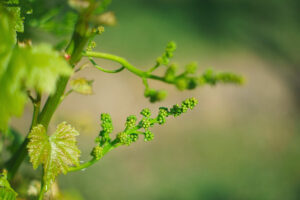Did you know that flowers grow on the vine?
In the world of grape growing and vineyard management, the abundant fall harvest is generally what springs to mind. But the stages leading up to this yearly bounty are crucial factors to success.
Spring is the grape’s best friend: plants in the vineyard begin to wake up and buds begin to appear, then flowering begins.
Winegrowers and winemakers carefully monitor when the flowering phase of their vineyards begins: this important phase of the grape growing season will determine the number of berries in each bunch.
Grape “flowering”( in vineyard manager parlance) comes in late spring, 40-80 days after bud break, depending on temperatures and rainfall. To make their welcome appearance, grape blossoms need average daily temperatures that stay between 59-68 °F.
The flower clusters are called inflorescences and emit a delicious fragrance that envelops the entire vineyard with sweet aromas.
It’s during this stage of a grape’s lifecycle that pollination and fertilization occurs, with the results ultimately producing a cluster.
For fertilization to occur, unlike many other plants, the bees don’t have to buzz in the vineyards. Grapevines are hermaphroditic – they possess both male and female parts so, barring weather issues or pest invasions, grape flowers can transform into berries all by themselves.
By the very nature of the plant, nearly 50 percent of the flowers in a given inflorescence are likely not to produce fruit.
During bloom, the delicate grape flowers are very vulnerable to damage from wind, rain or an unexpected late frost. Stress to the grape vines, including lack of water, can contribute to inflorescence necrosis, where the entire flower cluster is damaged. As you can imagine, losing entire flower clusters can be detrimental and is avoided if at all possible. Loss of the flowers within the inflorescence is called flower necrosis, and will result in grape clusters that have varied berry sizes, often referred to as hens and chicks. Carbon and nitrogen levels in the vineyard soil can also affect fruit set. For example, planting nitrogen-rich cover crops in a vineyard that is deficient will balance the levels and promote better fruit set than in those vineyards where nothing is done.
About 10-14 days after full bloom, fruit set should be well established and the pollinated flowers have begun to form small green berries that will eventually grow into individual grapes. At this time vineyard managers can begin to estimate the percentage of each grape cluster that will grow into fruit. While significant weather events can still affect the season, fruit set is the first indicator of how abundant (or not) harvest may be.
In other words, flowering literally is the pathway or power source for the vintage and puts the grapes on the branches.
The hardcore intervener
The weather plays a HUGE role in this process. Uneven temperatures, heavy rain, strong winds and hail can disrupt the cycle. Poor weather can abruptly shake off the pollen from the vines preventing some flowers from pollinating. The effects from cooler weather, including the incomplete pollination, can result in a smaller crop and less fruit per ache as branches are only able to develop half or 2/3 full of grapes.
Every vineyard manager wants an even fruit set, defined as when the fertilized flowers develop into a grape and then into picture-perfect clusters.
But if the delicate grape flowers are exposed to rain, wind or cold temperatures, the dream of a beauty-pageant cluster can be dashed. Low temperatures can freeze the flowers or a heavy rain can wash them off. This unwanted result is called “shatter,” meaning the cluster grows without the ideal, tight shape with the berries differing in size. While this variation thankfully doesn’t affect the quality of the berries, it definitely affects their quantity.
Once the tiny berries appear, we begin our leaf pulling or thinning practice. This crucial activity allows for increased air movement within the vine’s canopy, as well as helps manage light penetration through the vines. The breezes help keep non-beneficial pests at bay and the dappled light helps prevent sunburned grapes which can negatively affect a wine’s flavor.
With the right practices and if Mother Nature cooperates, grapevines thrive, especially in the temperate and normally predictable weather of Tuscany. We’re fortunate to grow vineyards here but we pay a lot of attention to everything to maintain the highest quality standards. We know it shows in the bottle 😉
